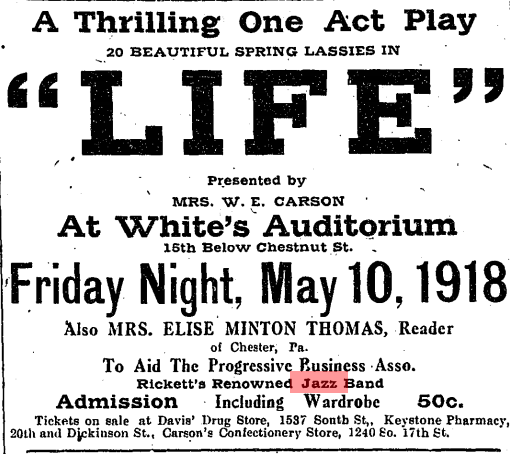Ragtime and Softshoe: Listening to History
As a part of @phillyhistory's #explore1918 initiative, I am writing about the music of 1918 in Philadelphia. To find out more, click here to read my post about Philly's African American musical landmarks! Or, read on to learn more about my newest project!
The Sound of 1918
As historians, we strive to tell emotional, relevant, and most importantly, interesting stories. Since starting my research into Philadelphia's musical history, I have focused on where those stories happened. Today, we're going to investigate what they sounded like:
Soft toed shoes hitting sanded floorboards. The driving rhythms of solo ragtime piano. Bursts of laughter from a 1600 seat theater.
Using the newspaper ads and programs of 1918, I wanted to reconstruct the soundscape of a night out in black Philadelphia. To do this, I searched through the records of the theaters and social clubs featuring black entertainers for the word "jazz." Mainly, I was just curious to find out how fast the craze had spread to Philadelphia after the first recordings hit the stores in mid-1917, but as I searched through, I kept coming across this band's name: Ricketts' (or Rickett's )Renowned Jazz Band.
A little later in my search, I came across an article that described one of their shows:
"The musicale which was offered in the first par was under the supervision of Robert Ricketts and was made up of a pleasing quartette number by the Graham Female Quartette, several pretty solos, buck dancing, and ragtime singing, all of which were enjoyed."
Let's take a closer look at some of those sounds!
"Ragtime Singing"
Jelly Roll Morton, "Hesitation Blues:" Morton played on the edge of ragtime and revolutionized early jazz with his stride/barrelhouse piano style. His composition, "Jelly Roll Blues," was the first jazz composition ever published.
"Buckdancing"
John Dee Holeman Flat-Footing: Now, this is kind of cheating. Buckdancing was a common vignette featured in vaudeville acts in the early 20th century, but this is actually Piedmont Flatfooting, a similar style native to North Carolina. From my limited research, I know that buckdancing originated in the South and is just one of the many origins of tap dancing and other solo African American dance styles. Holeman is a Piedmont Blues musician who also happens to be famous for his footwork.
And now you get to decide! What sound would you like to learn more about? What else do you want to know about ragtime singing, buckdancing, pretty solos, or the Graham Female Quartette?
100% of the SBD rewards from this #explore1918 post will support the Philadelphia History Initiative @phillyhistory. This crypto-experiment conducted by graduate courses at Temple University's Center for Public History and MLA Program, is exploring history and empowering education. Click here to learn more.
Sources Cited:
Alan Lomax Archive, "Flat-footing with John Dee Holeman and Algia Mae Hinton." Filmed 1983. YouTube video, 3:11. Posted April 2013.
Display Ad 6, Philadelphia Tribune, May 4, 1918, p. 4.
"Draft Treaty Between Great Britain and the US," February 23, 1918, p. 1.
"Hesitation Blues," Performed by Jelly Roll Morton. Traditional.

Loved these videos, @chelseareed!
Thanks, Ted! It's weird...I went on a Piedmont Blues internet research frenzy this summer. At the time, it was serious procrastination, but looks like it paid off lol.
Good stuff! Speaking of crossover and appropriation, Philadelphia played a major role in mainstreaming the banjo with the S.S. Stewart company at 221 Church Street Old City Coffee today, which manufactured an estimated 25,000 banjos there from 1878 to 1904.
Oh nice, I had no idea! There definitely needs to be some kind of exhibit or walking tour of old music stores in Philadelphia. Between world-renowned piano manufacturers and now banjo entrepreneurs, I think it'd be a cool way to explore the city's musical landscape outside of musicians/venues.
What did a night out in Philadelphia sound like one-hundred years ago? I am also interested in the sounds outside of the music. How did the audience sound between songs? What did the 1600 people talk about before and after the show? What were the accents like? Cool idea.
Ooo that'd be cool to pick a date and scan the newspaper for all the music happening that night! And I'm always interested in who went to go see what--so an audience accent/dialect study would be fun, too.